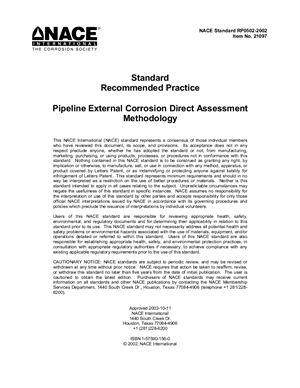57 стр.
NACE Inteational
This standard covers the NACE exteal corrosion direct assessment (ECDA) process for buried onshore ferrous piping systems. This standard is intended to serve as a guide for applying the NACE ECDA process on typical pipeline systems.
This standard was written to provide flexibility for an operator to tailor the process to specific pipeline situations.
ECDA is a continuous improvement process. Through successive applications, ECDA should identify and address locations at which corrosion activity has occurred, is occurring, or may occur.
ECDA provides the advantage and benefit of locating areas where defects can form in the future rather than only areas where defects have already formed.
Comparing the results of successive ECDA applications is one method of evaluating ECDA effectiveness and demonstrating that confidence in the integrity of the pipeline is continuously improving.
ECDA was developed as a process for improving pipeline safety. Its primary purpose is preventing future exteal corrosion damage.
This standard assumes exteal corrosion is a threat to be evaluated. It can be used to establish a baseline from which future corrosion can be assessed for pipelines on which exteal corrosion is not currently a significant threat.
ECDA as described in this standard is specifically intended to address buried onshore pipelines constructed from ferrous materials.
NACE Inteational
This standard covers the NACE exteal corrosion direct assessment (ECDA) process for buried onshore ferrous piping systems. This standard is intended to serve as a guide for applying the NACE ECDA process on typical pipeline systems.
This standard was written to provide flexibility for an operator to tailor the process to specific pipeline situations.
ECDA is a continuous improvement process. Through successive applications, ECDA should identify and address locations at which corrosion activity has occurred, is occurring, or may occur.
ECDA provides the advantage and benefit of locating areas where defects can form in the future rather than only areas where defects have already formed.
Comparing the results of successive ECDA applications is one method of evaluating ECDA effectiveness and demonstrating that confidence in the integrity of the pipeline is continuously improving.
ECDA was developed as a process for improving pipeline safety. Its primary purpose is preventing future exteal corrosion damage.
This standard assumes exteal corrosion is a threat to be evaluated. It can be used to establish a baseline from which future corrosion can be assessed for pipelines on which exteal corrosion is not currently a significant threat.
ECDA as described in this standard is specifically intended to address buried onshore pipelines constructed from ferrous materials.

